What Is Autism
Autism Spectrum Disorders are fast becoming the most pervasive child development disability around. More common than Down’s Syndrome and Cerebral Palsy, autism spectrum disorders affect one in every four children in the United States. Out of those children, three out of four will be boys. Because the disorders have numerous conditions affecting child growth and development, no two children with autism are exactly alike and no two children with autism disorders have the same issues. It’s a complicated spectrum which requires numerous specialists and tests to properly diagnose and confirm the diagnosis. Most children with autism look completely normal from birth, and there is no prenatal test to check for the disorders, which only complicates the process as no pediatrician can look at a child and readily see that he or she will develop an autism disorder.

Types of Autism
Because it’s difficult to determine just where on the spectrum a child with autism falls, there are several sets of diagnostic criteria as well as four major categories of autism. The four major categories of autism are: Autism, Aspergers, Autism Spectrum Affective Disorder and Pervasive Developmental Disorder-Not Otherwise Specified or PDD-NOS. In all cases children start their development after birth at a reasonably normal rate. Some might be slightly slower than their peers but since a child’s developmental markers are met at a slightly different age for every child, this is not an immediate concern. It becomes a concern however when the child in question can’t smile, focus on objects, sit up or walk, or interact with parents by the time he is a year to a year and a half old. Routine well baby visits with a pediatrician will help document whether the child is developing normally or should be referred to a specialist. Since many of these issues can also be attributed to other developmental delay disorders, all the other disorders have to be ruled out before Autism is considered. Read in details about, “types of autism”
Autism Symptoms
What are the characteristics of autism? Straight up, “run of the mill” Autism addresses delays in more than one important area of development and usually has to be present in two to three areas for an extended and well-documented period of time. Children with Autism of the “regular” variety have speech delays and communication issues, either in their receptive or expressive communication, or both. They may be nonverbal all together, or they may make noises like humming, screaming, whining, or something akin to wordless singing. Conversely they will also exhibit advanced academic skills beyond that of children of the same chronological age. Repetitive movements like rocking on stationary furniture, spinning nonstop, wringing or flapping of the hands are characteristic of a child with autism and are done as a means of self stimulation and sensory input. Delays in toilet training, walking, running, throwing a ball, etc. are also possible as the muscle groups haven’t found a way to work together that the child with autism both understands and is comfortable with.

A child with autism may also be sensory defensive, i.e., sounds, tastes, textures, sights, and smells may overwhelm and hyper stimulate them or the opposite end is also true where the child can’t make things loud enough(even though their hearing is excellent) or soft enough, or hard enough, or the texture of their food needs to be coarser or the tub water needs to be slightly less than tepid before they’ll get in. This has a lot to do with the fact that children with autism lack effective sensory filters and can’t filter and process everything separately. They may also be extremely picky eaters or suffer from pica, an eating disorder where unusual substances like dirt, oil, metal or other potentially harmful things are consumed if not removed from their reach. Fixations similar to obsessive-compulsive disorder that last from a few weeks to a few years are not uncommon either.
Asperger In Children
The child with Asperger’s on the other hand, will appear to develop in a completely normal fashion, hitting all the right development marks and even learning to speak at the right time. Speech is the biggest component in diagnostics when it comes down to assessing whether a child has autism or Asperger’s. The easiest thing to remember about the two is that Asperger’s children speak when they’re supposed to, children with autism do not. Because children with Asperger’s are not diagnosed until later in life because their developmental milestones are all hit on time, it makes it significantly harder to provide corrective therapy for them. Usually a parent will notice that their child of eight or nine doesn’t get along with his peers or that they have very few, if any, friends. Unlike a child with autism who doesn’t make eye contact a child with Asperger’s will, but it is often unsustainable and lasts seconds to a minute or two. They have trouble with expressions of speech, metaphors, idioms, and similes, which higher functioning and verbal children with autism also encounter. Language has to be direct and free of these types of verbal expression in order for these children to be understood and to understand those addressing them. It can be very frustrating for friends and family to alter the way they think and talk in order to make themselves understood to children with Aspbergers and high-functioning autism, but habitually it gets easier.
Probably the most frightening thing for parents of children with Asperger’s and high-functioning autism is when their child or children develop aggressive behaviors that are either hurtful to the child himself or to others. Forty years ago, such behaviors landed them in an institution; now early intervention and therapy can really help. It is still a good idea, however, to keep potential weapons out of the reach of children who are expressing anger and frustration with acts of violence. “who diagnoses Asperger’s?
Autism Spectrum Affective Disorders are argued by professionals to not exist. They feel that the child has to fall into a more specific category and level of functioning. Most times this diagnosis is only used in conjunction with a primary diagnosis of Down’s Syndrome or other more prominent and serious developmental delay. Thus the children with this secondary or tertiary diagnosis exhibit autism like behaviors, such as high intelligence quotients, hyperlexia, or outstanding rote memory skills in conjunction with diagnoses that should involve mental retardation.
Finally, Pervasive Developmental Disorder-Not Otherwise Specified, or PDD-NOS abbreviated, is the diagnosis handed to children who obviously fall within the spectrum but not enough evidence exists to make a clear cut diagnosis between Asperger’s and autism itself. Oftentimes little girls, who typically are thought to not be able to develop autism as it has been seen as a “boys’ developmental delay disorder”, but still exhibit autistic tendencies like their brothers or male peers will be diagnosed as PDD-NOS. As the child grows and his or her development can be more readily documented and tested by professionals, this diagnosis is changed to something more specific or dropped all together if it seems the child was just delayed for other causes and has caught up to his or her peers. Children who are diagnosed with PDD-NOS have a lot of the earmarks for autism or Asperger’s; delayed physical development, delayed social development, delayed language or ability to adequately express themselves, self-abuse or abuse of others, and significant hyper development of academics.
What to Do When Your Child is Diagnosed With Autism

So what can be done if you discover that your child has an autism spectrum disorder? Lots, if it’s diagnosed early and you have plenty of medical documentation to back it up. Even high-functioning children with autism can get Federal Social Security and Disability Income, if the evidence shows that they problems they face are severe enough to interfere with everyday activities. Also, every state is a little different, but long term care waivers for children with autistic disorders have to be applied for before the child turns seven, eight or nine. These waivers then allow for long term care to be planned for and planned ahead, and in-home intensive therapy sessions with specially trained therapists aid the family, as well as the child into coping, managing and growing into a fairly well-adjusted and potentially productive adult, depending on the severity of the disorder and the patience, persistence and training of the therapist.
Some states will also add funds to the Federal SSDI funds every month for families that struggle financially and/or have more than one child with special needs. This fiscal assistance, in turn, helps parents find suitable childcare if they work or respite when they need a break from the challenges of the day with their child. The money is also used to shelter, care for, clothe, feed, and supply the child with an autistic spectrum disorder anything else they would need during the year, including co-pays for medicine and doctors’ visits. This makes a big impact on how children with these needs can stay at home rather than being institutionalized like they were so many years ago. “Can i get paid to take care of my autistic child?” or”Can I get SSI for my autistic child?”
Many children with autism are also mainlined into the public schools now. This means that, if they can understand, talk and learn they spend time more inside a standard classroom than they do in a special education room. This aids them in learning the social skills they need to function later on and they are more of intellectual sponges than even their peers. They quickly learn everything and absorb even more because they do not have the filters everyone else has. Obviously then this is both a burden and a gift for them, a two-edged sword that can be managed with a good teacher at the head of the room.
Technology also plays a part in how these children communicate. Because of iPads and Smart Boards, these children can take what was once a paper and velcro system of communicating and apply it through technology. It is obvious to anyone who’s observed them that technology, for whatever reason, makes sense to these kids. Theoretically, it is because technology doesn’t require them to interact with humans nor provide eye contact nor make sense of phrases like “it’s raining cats and dogs” that children with autism spectrum disorders find it so much easier to communicate through and iPad or Smart Board. It does unfortunately defeat the purpose of treating the autism’s social and communicative hindrances, unless the child is completely nonverbal. Will my autistic child ever get better?
What Really Causes Autism
Lastly, it must be said. No one knows what causes autistic disorders. There are several theories but no one has the proof yet. What they do have are brain scans of children and adults with autism that clearly show a difference in structure and size, so medical scientists are working off of that proof to find the cause. In short it is a neurological issue, in that there is brain damage so to speak. There are no medications to prevent it, no medications to treat it, and nothing to cure it. It is more prevalent now, today, because more children are being diagnosed sooner and recorded in the data files of medicine, not that it’s more prevalent because something current is the cause.
The most recent and highly probable theory is that the mothers who have children with autism were extremely stressed and depressed during the pregnancy, which raised certain levels of biochemicals in the body and altered the child’s brain development in utero. There appears to be some link genetically as well, as some families have more than one child affected by an autistic spectrum disorder. There remains an insurmountable task by medical researchers to sift through all the true evidence and weed out the junk science to find that which causes the brains of these children to stop growing and functioning normally. With the advancements of genetic maps of genomes and hereditary conditions, as with Rhett’s Syndrome, which has been determined to have genetic marker codes and thought by some doctors to be part of the Autism Spectrum disorders, there will no doubt one day be an answer to the bizarre and confusing riddle that is Autism Spectrum Disorders, and hopefully a cure or prevention will follow.
Written by,
Kylie White
You do realize that you will get credit from each individual of our prayers will for helping us. Thanks and could Allah bless you.